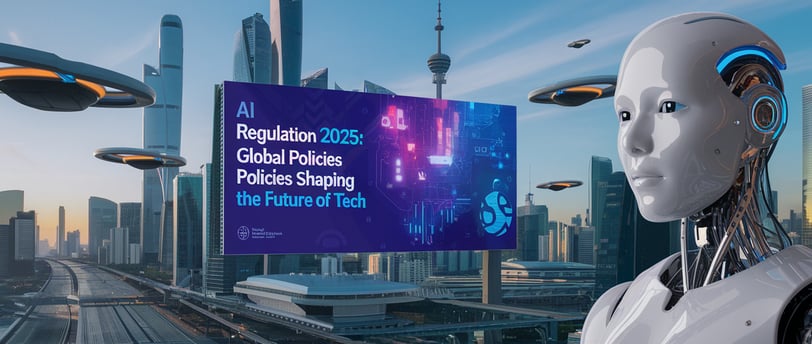AI Regulation 2025: Global Policies Shaping the Future of Tech
Artificial intelligence has evolved from a niche technological curiosity to the backbone of modern innovation. By 2025, AI systems will power everything from healthcare diagnostics to autonomous vehicles, financial algorithms, and even creative industries. But as AI’s influence grows, so do concerns about ethics, accountability, and safety. Governments worldwide are stepping in to craft regulations that balance innovation with societal protection. In this blog, we’ll explore the global policies set to redefine AI in 2025, their real-world implications, and how they’re shaping the future of technology.


The Rise of AI Regulation: Why Now?
AI’s rapid advancement has outpaced existing legal frameworks. High-profile incidents—such as biased hiring algorithms, deepfake misinformation campaigns, and fatal autonomous vehicle crashes—have fuelled public demand for oversight. By 2025, regulators aim to address three core challenges:
Transparency: Ensuring AI systems are explainable and free from “black box” obscurity.
Accountability: Assigning legal responsibility for AI-driven decisions.
Ethics: Preventing discrimination, privacy violations, and existential risks.
Let’s dive into the policies leading this charge.
Key Global AI Policies in 2025
1. The European Union’s AI Act: A Risk-Based Framework
The EU’s landmark AI Act, finalized in 2024, is the world’s first comprehensive AI regulation. It classifies AI systems into four risk tiers:
Unacceptable Risk: Banned applications (e.g., social scoring, real-time facial recognition in public spaces).
High Risk: Strictly regulated (e.g., healthcare diagnostics, critical infrastructure).
Limited Risk: Transparency requirements (e.g., chatbots disclosing their AI nature).
Minimal Risk: Unregulated (e.g., AI-powered video games).
Real-World Impact:
Healthcare giant Siemens Healthineers delayed the rollout of its AI-driven MRI analysis tool in 2025 to comply with new “high-risk” audit requirements.
French start-up Mistral AI pivoted from developing emotion-detection systems (deemed “unacceptable risk”) to enterprise data analytics.
2. U.S. State-Level Regulations: A Patchwork Approach
Unlike the EU, the U.S. lacks federal AI legislation. Instead, states like California, Colorado, and New York have taken the lead:
Colorado’s AI Consumer Protection Act (2024): Mandates bias audits for AI used in hiring, lending, and housing.
California’s Autonomous Vehicle Safety Initiative (2025): Requires real-time data sharing between self-driving cars and state traffic systems.
Real-World Impact:
Tesla’s Full Self-Driving (FSD) software now includes a “California Mode” that shares anonymized sensor data with regulators.
HR tech firm HireVue abandoned facial analysis for job screenings after Colorado’s bias audit law exposed inconsistencies in its algorithms.
3. China’s AI Governance: State Control and Innovation
China’s 2023 Generative AI Regulation emphasizes state oversight while fostering dominance in strategic sectors like semiconductors and smart cities. Key rules include:
Mandatory security assessments for AI models trained on Chinese data.
A ban on AI-generated content that “subverts state power.”
Real-World Impact:
ByteDance’s Douyin (China’s TikTok) uses government-approved algorithms to censor politically sensitive content.
Baidu’s ERNIE 4.0, a ChatGPT rival, operates under strict content filters to align with Communist Party directives.
4. Global Collaboration: The OECD AI Principles
Beyond regional laws, 42 countries have adopted the OECD AI Principles, a non-binding framework promoting transparency, accountability, and human-centric design. While not enforceable, these principles guide corporate policies at firms like Google and Microsoft.
AI Regulation in Action: Industry Applications
Healthcare: Saving Lives, Under Scrutiny
AI’s potential in medicine is staggering—from predicting sepsis to personalizing cancer treatments. But regulations demand rigorous validation.
Example: The FDA’s 2025 AI Medical Device Amendment requires continuous monitoring of AI diagnostic tools. Epic Systems’ sepsis prediction model now undergoes monthly audits to ensure accuracy across diverse patient demographics.
Autonomous Vehicles: Navigating Legal Roads
Self-driving cars promise safer roads, but liability remains murky.
Example: After a 2024 Uber AV collision in Toronto, Canada’s federal government mandated “driver logs” for AI systems to reconstruct decision-making processes. Companies like Waymo now store 360-degree sensor data for every trip.
Content Moderation: The Deepfake Dilemma
AI-generated deepfakes threaten elections and reputations.
Example: Under the EU’s Digital Services Act (2025), platforms like Meta must label or remove AI-generated political content within 24 hours. OpenAI’s DALL-E 4 embeds invisible watermarks in all outputs to track misuse.
Challenges Ahead
While 2025’s regulations mark progress, hurdles remain:
Innovation vs. Safety: Startups argue compliance costs stifle creativity.
Global Fragmentation: Differing rules complicate cross-border AI deployment.
Enforcement: Who polices AI? Regulators lack technical expertise, relying on third-party auditors like IBM’s AI Ethics Board.
The Future of AI: Collaboration or Chaos?
By 2025, AI regulation will no longer be optional. The question is whether governments, corporations, and civil society can collaborate to create standards that protect without stifling. Early signs are promising:
The Global Partnership on AI (GPAI), a 29-nation alliance, is drafting ethics guidelines for military AI.
IBM and Microsoft have open-sourced tools to automate regulatory compliance.
For businesses, adaptability is key. Those embracing transparency—like Salesforce’s “AI Nutrition Labels” detailing data sources—will thrive. Those resisting will face fines, bans, or public backlash.
Conclusion
The year 2025 will be remembered as the moment AI grew up. No longer a wild frontier, it’s becoming a regulated industry akin to finance or aviation. The stakes are high: get regulation right, and AI could uplift humanity. Get it wrong, and we risk entrenching bias, eroding privacy, or worse. As consumers, developers, and policymakers, we all have a role in shaping this future—one algorithm at a time.
Explore
Discover premium eBooks across various engaging genres.
Read
Tell us what our next ebook should be about!
© 2025. NEWGENREADS.COM All rights reserved.
